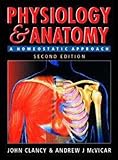Physiology and anatomy : a homeostatic approach / John Clancy, Andrew J. McVicar ; principal nursing advisor Christine Barrett.
Material type: TextPublication details: London : Arnold, c2002.Edition: 2nd edDescription: xii, 736p. : col. ill. ; 27 cmISBN:
TextPublication details: London : Arnold, c2002.Edition: 2nd edDescription: xii, 736p. : col. ill. ; 27 cmISBN: - 9780340762394 (pbk.) :
- 034076239X
- 612 CLA
- QP34.5 .C53 2002
| Item type | Current library | Call number | Copy number | Status | Date due | Barcode | |
|---|---|---|---|---|---|---|---|
| Long Loan | TUS: Midlands, Main Library Athlone General Lending | 612 CLA (Browse shelf(Opens below)) | 1 | Available | 128316 | ||
| Long Loan | TUS: Midlands, Main Library Athlone Nursing Collection | 612 CLA (Browse shelf(Opens below)) | 1 | Available | 119524 | ||
| Long Loan | TUS: Midlands, Main Library Athlone General Lending | 612 CLA (Browse shelf(Opens below)) | 1 | Available | 119522 | ||
| Long Loan | TUS: Midlands, Main Library Athlone General Lending | 612 CLA (Browse shelf(Opens below)) | 1 | Available | 119523 | ||
| Long Loan | TUS: Midlands, Main Library Athlone General Lending | 612 CLA (Browse shelf(Opens below)) | 1 | Available | 119521 |
Previous ed.: 1995.
Includes bibliographical references and index.
SECTION 1: An Introduction to the Human Body:- 1. Introduction to physiology and homeostasis -- Introduction to the human body, its organization, and the homeostatic basis of body functions--Levels of organization--Homeostasis: the link with health and ill-health--Homeostasis and ill-health--Conclusion--References--Further reading--2. Cell and tissue functions --Cellular level of organization--cellular anatomy and physiology--Homeostatic mechanisms by which substances are transported across the cell membrane--Cell organelles--Genes and cell division--Tissues and tissue function--Organs--Organ systems--References--Further reading-- 3. The Skeleton -- Introduction--Anatomy and physiology of bone--Anatomy of the skeleton--References--SECTION 2: The Need for Regulation:- 4. Chemical reactions in cells: metabolism --Basic chemistry--Metabolism: a general overview--Cellular respiration--Further reading-- 5. Nutrients and nutrition --Introduction--The chemicals of life, and their dietary sources--References--6. Body fluids --Introduction--Body fluid compartments--Actions of water and electrolytes, and principles of body fluid homeostasis--Use of infusates in practice to support body fluid compartments--References--SECTION 3: Sensing change and co-ordinating responses:- 7.The Senses --Introduction--Receptors and their roles--The special senses--References-- 8. The nervous system --Introduction--Overview--Anatomy of the brain--Anatomy of the spinal cord--Neural physiology--The autonomic nervous system--References--Further reading--9.The endocrine system --Introduction--Overview of the anatomy, physiology and chemistry of the hormonal system--Homeostatic functions of the hormones--Further reading--SECTION 4: Effectors of Homeostasis:- 10. The digestive system --Introduction: relation of the digestive system to cellular homeostasis--Regulation of food intake--Overview of the anatomy and physiology of the digestive system--General history of the gastrointestinal tract--Physiology of the digestive system--References--Further reading--11. The cardiovascular system 1: Blood --Introduction--Overview of the composition of the blood--Composition and physiology of the blood--Wound healing--Blood groupings--References--Further reading--12.The cardiovascular system 2: The heart and circulation --Introduction: relation of the cardiovascular system to cellular homeostasis--Overview of the anatomy and physiology of the cardiovascular system 1: the heart--Overview of the anatomy and physiology of the cardiovascular system 2: blood vessels and circulation--Cardiac physiology--Circulatory physiology--References--Further reading--13. The lymphatic system and immunity --Introduction--Overview of the anatomy and physiology of the lymphatic system--Physiology of the lymphatic system: lymph formation--Physiology of the immune system: the immune responses and defence mechanisms--References--Further reading-- 14.The respiratory system --Introduction--Overview of lung anatomy, and general principles of lung functions--Physiology of the respiratory system--Regulation of the respiratory system--References--15.The kidneys and urinary tract --Introduction--Overview of the anatomy and physiology of the kidneys--Kidney functions--The bladder and control micturition--The kidneys and homeostatic control of body fluid composition and volume--References--16.The skin --Introduction--Anatomy of the skin--Regulating body temperature-- References--17. Posture and movement --Introduction--Overview of skeletal muscle anatomy and physiology--Muscle contraction--Control of posture and movement--References--18.The reproductive systems--Introduction: relation of reporduction to homeostasis--Overview of the anatomy and physiology of the human reproductive systems--Reproductive physiology--physiology of birth control--References--Further reading--SECTION 5: Influences on Homeostasis:- 19. Nature - Nurture: An individualized approach to health and healthcare --Introduction--Integrated approaches to health and healthcare--References--Acknowledgement--20. Genes in empryo development and ageing --Introduction--Embryo development, and the role of genes as mediators of tissue differentiation--The fundamentals of inheritance: genes, alleles and cell division--Principles of the inheritance of characteristics--Genes and ageing--Implications of advances in genetics for healthcare--Referencces--21. Pain --Introduction--Neurophysiology of pain perception--Pharmacological pain management--Non- Pharmacological techniques of pain management--Assessment of pain--References--Further reading--22. Stress -- Introduction--The subjectivity of stress--The subjectivity of stress responses--Coping mechanisms and features of failure--References--Further reading--23. Circadian rythms --Introduction: relation of rythms to humans--Control of circadian rythms in homeostasis--Circadian rythm desychromization: a homeostatic imbalance--References--Further reading--SECTION 6: Homeostasis in action: Case Studies:- 24. Adult care case studies --Case 1: a woman with breast cancer--Case 2: a man with chronic bronchitis--Case 3: a man with myocardial infarcation--Case 4: a man with benign prostatic hyperplasia--Case 5: a young woman with secondary (renal vascular) hypertension--Case 6: a woman with rheumatoid arthritis-- 25. Childcare case studies --Case 1: a boy with asthma--Case 2: a child with insulin-dependent diabetes mellitus--Case 3: a febrile toddler--Case 4:a boy with leukaemia--Case 5: a baby boy with necrotizing enterocolitis--Case 6: a child with hypertrophic pyloric stenosis--26. Mental healthcare case studies --Case 1: a man with Alzheimer\'s disease--Case 2: an adolescent girl with anorexia nervosa--Case 3: a man with depression--Case4: a woman with Huntington\'s disease--Case 5: a young man with schizophrenia--Case 6: Distress-- 27. Learning difficulty care case studies--Case 1: a man with down\'s syndrome--Case 2: a girl born with cytomegalovirus inclusive body disease--Case 3: a man with learning disabilities leaving a long-stay institution--Case 4: a man with phenylketonuria--Case 5: a man with self-injurious behaviour--Case 6: a young man with sensory deprivation.
Concentrating on the homeostatic principles of human physiology, this text emphasises the role of each body system in the maintenance of an optimal environment, and explains how disturbances of homeostatic mechanisms promote illness.
